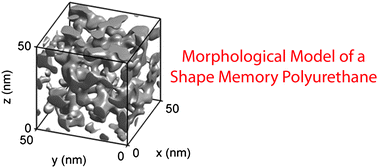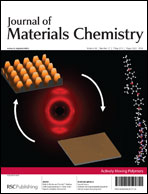Modeling the morphology and mechanical behavior of shape memory polyurethanes based on solid-state NMR and synchrotron SAXS/WAXD†
Abstract
A combination of solid-state proton Wide-line Nuclear Magnetic Resonance (NMR) relaxometry and synchrotron Small-angle (SAXS) and Wide-angle (WAXD) X-ray scattering was used to elucidate the microphase morphology of shape memory thermoplastic multi-block polyurethanes based on poly(ε-caprolactone), as switching segment and polyurethane based permanent or hard segments (HS). The polyurethanes are produced from the condensation of 1,4-butanediol (BDO) with hexamethylenediisocyanate (HDI). The morphology – induced by the hard-segment crystallization – converts from dispersed randomly placed hard-segment domains into progressively more periodic, but interconnected HS nanophases with increasing HS content. Irrespective of the actual morphology, the SAXS data could be described satisfactorily by using a clipped Gaussian random field (GRF) model. The NMR data demonstrate that the HS domain fraction corresponds to the chemical feed, pointing at a complete phase separation. The material mechanical behavior during repeated deformation cycles can be explained on morphological grounds and involves a spatially heterogeneous plastic deformation of the hard domains.

- This article is part of the themed collection: Actively Moving Polymers

 Please wait while we load your content...
Please wait while we load your content...